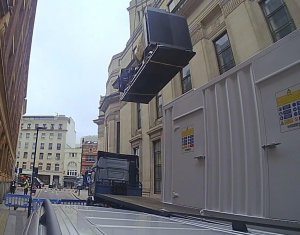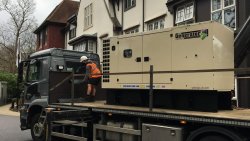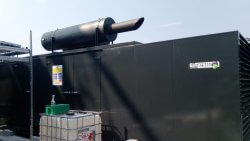United Grand Lodge of England; one of the oldest social and charitable organisations in the world, the roots of modern Freemasonry lie with the medieval stonemasons that built our castles and cathedrals, yet it is as relevant today as it was hundreds of years ago. Claiming descent from the Masonic grand lodge formed 24 June 1717 at the Goose & Gridiron Tavern in London, it is considered to be the oldest Masonic Grand Lodge in the world. There have been three Masonic buildings on the site, with the current incarnation being opened in 1933.
The two World Wars both had a great effect on English Freemasonry. In the three years after the First World War over 350 new Lodges were set up, and in the three years after the Second World War nearly 600 new Lodges came into being. In many cases the founders were servicemen who wanted to continue the camaraderie they had built up during their war service, and were looking for a calm centre in a greatly changed and changing world.
On 14 June 1967 the 250th anniversary of Grand Lodge was celebrated at the Royal Albert Hall. Centrepiece of the celebrations was the installation as Grand Master of HRH The Duke of Kent, who still holds that office today.

See time lapse video of offload
Having previously carried out generator project works for the customer, a Kent based family run business providing temporary electrical and construction services, we were very happy to oblige when they contacted us to supply and install a standby generator for the oldest Masonic Grand Lodge in the world based in one of the finest Art Deco buildings in London. Still used for its original purpose, Freemasons’ Hall welcomes more than 200,000 people from across the world through its doors every year, including members visiting for meetings and guests attending special events.
The United Grand Lodge of England, based at Freemasons’ Hall in London, was originally built as a peace memorial to honour the thousands of Freemasons who fought during the First World War.
Freemasons’ Hall surprisingly has never had back up power installed and as an in-demand venue, a working building as well as featuring in numerous Hollywood blockbusters and television programmes in recent years, including The Crown, Spectre, Sherlock Holmes, Assassin’s Creed and Spooks, back-up power is vital to ensure that filming along with the day to day running of the building is not disrupted by a power outage.
Prior to submitting a proposal, our sales manager attended an initial site survey to ascertain the specific power requirements of the end client and determine any site restrictions, enabling us to offer a bespoke solution for the project.
The project initially posed several challenges which needed to be overcome; primarily we needed to take into consideration the listed status of the building when delivering the equipment; mounting the exhaust flue and fill point cabinet; the limited space in the courtyard area where the generator was to be positioned and the method in which the equipment would be craned into the courtyard from outside the building.
The London Borough of Camden and Westminster Council had also issued planning conditions due to the location of the building to safeguard and protect the quality of life of the occupiers and neighbours and to ensure that noise and vibration from the generator was controlled and managed.
An internal meeting was arranged with our Projects Division to consider the best way in which to manage these challenges. Following discussions an initial solution was reached to enable our sales manager to submit a proposal to the customer:-
- Method of moving the equipment into the courtyard
Following discussions with several crane companies it was determined the best option was to obtain a road closure for the road adjacent to the building, which in itself would be challenging due to the fact the building was on a main feeder road through Covent Garden and the works would be carried out over a weekend, and to use a mobile crane to lift the equipment up and over the building to drop into the courtyard for final positioning. A structural inspection was carried out by the crane company to ensure the stability of the ground for the weight of the crane and to check for basements or building voids beneath the road.
- Fuel system
Our original proposal comprised a 14,000ltr bulk tank with a 1,500ltr 8 hour day tank and 5 meters of pipework from bulk tank to day tank, but due to shortage of space within the courtyard and uncertainty of the strength of the floor due to the tunnels underneath the building the proposal was revised to include a 3,761ltr bulk tank with a fuel polisher and 5 meters of pipework flow and return from tank to generator to sit on a platform next to the generator underneath the air inlet attenuator.
Our Acoustic Solution company offered a design that allowed for 24 hour fuel storage and a canopy to allow air in and out of the inlet and discharge attenuators to stop any overheating issues due to the way air will flow into the courtyard.
- Fill point cabinet
Due to the listed status of the building, the planners would not allow for an external fill point cabinet to be fitted to an external wall. We overcome this hurdle by fitting it in an unused external window to ensure the façade of the building would not be changed.
- Exhaust flue
The exhaust flue was to be extended to allow for positioning above roof level and painted the same colour of the external wall of the courtyard to ensure that the aesthetics of the building wasn’t altered.
Subsequent to the initial proposal being sent, further site visits and discussions followed with the customer and end-client to discuss planning restrictions/constraints arising from the issued proposal. This followed with a revised proposal submitted recommending a 1 x 900kVA standby rated Cummins engine powered generator set complete with a set mounted DeepSea 8610 control panel and MCCB circuit breaker for isolation and protection purposes, a 3761lt fuel day tank suitable for 24 hours running and a fuel polisher all contained within an acoustic enclosure to reduce noise pollution and an extended stainless steel twin wall exhaust flue from exhaust silencer to high level above roof level (40 meters vertical to top of building).
Following Council approval and final authorisation from the customer and the end-client, our Project Manager liaised with the customer to book the installation into our Program of Works Schedule allowing enough time for the customer to apply for the temporary road closure, the removal of the bike shed, installation of the concrete plinth ready for the equipment and installation of the flue by our specialist installers.
On the agreed date our installation team delivered the equipment to site utilising two of our own HiAb lorries where they were met by the crane company and their 500 ton mobile crane that was set up and waiting to start loading from the roadway adjacent to the building.
Once everyone was in place, the equipment was offloaded onto the prepared plinth in the following sequence:-
- Generator set
- Enclosure
- Outlet duct
- Fuel Day Tank
- Inlet attenuator
- Exhaust silencer
Check out the time lapse video of the equipment being expertly offloaded
Our engineers located inside the courtyard oversaw each section into its final position. Once all items had been expertly lifted and positioned into place by the crane team our engineers installed all the fixing bolts to secure each section of the enclosure.
After all the equipment was connected and the final connection of exhaust to flue it was followed by a very satisfactory site acceptance test carried out by our electrical engineer to test the generator’s performance under differing power loads to guarantee its operating specification. This was subsequently followed by the commissioning of the set including a black building test to take down the power to ensure the generator starts up in the event of a power outage.
We left behind a fully functioning standby generator, a clean and tidy site and a very happy customer and end-client that we look forward to working with again in the near future.






